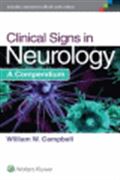The aim of this book can be summarised by defining the word Compendium, a point that is perhaps laboured slightly in the preface. A “concise compilation of a body of knowledge” does, however, accurately describe the contents, whose emphasis is on discussing those signs which have value in clinical practice.
An additional aim of the book is to increase the reader’s familiarity with a selection of signs so specific to certain conditions that, upon recognition, the diagnosis can be made. Although the term “spot diagnosis” is perfectly adequate in describing these scenarios, I much prefer the descriptive term “augenblickdiagnose” used in the book. Campbell points out, through the medium of Goethe, that “One sees only what one knows”. This emphasises the utility in familiarizing oneself with the small print of one’s speciality, whilst incidentally enriching the Teutonic theme.
Although the target audience is not specified, one can infer from the wide-range of topics covered that this book has the jobbing Neurologist in mind. In my opinion, it would better serve the post-graduate neuro-enthusiast than it would the (potentially befuddled) undergraduate.
The book is organised in alphabetical order, rendering the contents page somewhat redundant. It reads like a succinct and exquisitely illustrated encyclopaedia, with a startling variety of clinical signs covered. These signs are indexed at the back, allowing for quick reference if you have a specific query. Like any book of this nature, the style is somewhat self-referential. This is not obtrusive however, and does not interfere with the reading experience. It never falls into the tedious, involutional loops of direction and re-direction that can be encountered in some reference texts.
The addition of an e-book gives a wealth of demonstrative video content. These videos were largely provided in the form of in-text links, which re-directed to a number of sources, quite a few of which appeared to be readily accessible to the intrepid googler. However, the curatorship provided in collecting these high quality resources, combined with the £0 price tag on the e-book justifies their inclusion.
I was disappointed that the author did not take the opportunity in the e-book to offer any alternatives to the alphabetical categorisation system employed in the print edition. Organisation of the signs by disease or relevant part of the neurological examination would be a useful alternative; I would have thought it well within the capabilities of the e-book.
At £45, this book represents excellent value. I might find myself reaching for it – beset by obscure, eponymous signs in historical letters, encountering a ‘heretofore’ unheard of finding during grand rounds or, when trying shamefully to add a little grandeur to my own examination findings in clinic. For these reasons, I think an institutional copy would be ideal.
However, I think the book’s greatest success is the manner in which a brief perusal can drastically reduce the readers “unknown unknowns”. This harks back to one of the original aims, to increase familiarity with one’s speciality. In this, I think the book can be considered a triumph. I would recommend a personal copy to anyone with a genuine curiosity about neurology: it is as equally suited to specific interrogation as to idle exploration, with rewards to be gained from both.
ACNR 2016: V15:I6. Online 09/02/2016

